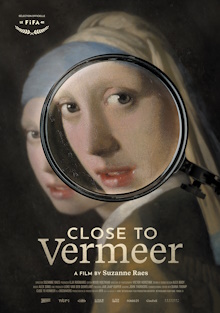This documentary tells the behind the scenes story of the exhibition of the largest collection of Johannes Vermeer ever that was mounted in 2023. It was needless to say a tremendous success with its limited number of time slots being sold out immediately. We’ll never get to see its like in person but this documentary at least gives us some idea of what it’s like as well as a fascinating look into the kind of work that goes into organizing such events. The film does assume that one has already some basic idea of who Vermeer was and his significance and there are no grand revelations or new insights on offer but it’s an interesting and educational documentary all the same.
As the film itself states, there are two inherent difficulties when talking about Johannes Vermeer. One is that he has a relatively small body of work attributed to him, only about 34 paintings. Second is that we know where he lived and worked, but almost nothing else. He stayed in the town of Delft in the Netherlands throughout his life and nothing is known about where he learned to paint and he had no known students. Today he is considered one of the greatest painters of all time and many of his works are instantly recognizable. This documentary is a companion piece to an effort to collect as many of Vermeer’s paintings as possible for an exhibition at the Rijksmuseum in Amsterdam. To this end, curator Gregor Weber travels across the world to convince others to lend out their paintings, adding to the four already in the possession of the Rijksmuseum. Other experts who appear include Jonathan Janson, a painter who in attempting to recreate Vermeer’s paintings, explains to the layman the subtleties of the techniques he used, and Abbie Vandivere who talks about using modern scanning technology to uncover deeper secrets about the paintings.
While there’s not much in the way of drama here, it does cover a kerfuffle over the authenticity of Girl with a Flute. Its owner, the National Gallery of Art in Washington D.C. argues that it is not a Vermeer as its painter was unable to achieve his level of expertise. The Rijksmuseum however continues to believe that it is a Vermeer and includes it as such in their exhibition. It is kind of interesting to us that they worried about how their decision would be taken by their American counterparts and the camera isn’t allowed in the meeting room where they hash out their differences. I was also amused by the minor drama surrounding A Young Woman Seated at the Virginals, the sole Vermeer painting in private hands. The experts all seem to think that it is a subpar work, perhaps made by Vermeer when he was sick or in failing health. Yet they can’t exactly say that out loud in the presence of the painting’s owner the billionaire Thomas Kaplan, especially when he’s doing them a favor by lending them the painting. So director Suzanne Raes takes this as a chance to have a bit of fun as the film takes on a reality show feeling as the camera cuts between Kaplan and Weber’s faces as the former tells the story of how he bought the painting.
I appreciate it for showing how the staff physically prepares and handles these paintings, and the extreme amount of care they put into considering where and how to display the pieces. It also goes into how Vermeer may have used a camera obscura as a painting aid but it is very careful to say that he didn’t directly trace out what he saw. All in all, this isn’t the kind of documentary that is going to light a fire under you. It covers all the bases, portrays the interviewees in a good light and generally its job as a companion piece to a hugely significant exhibition. That’s good enough for me but of course your mileage may vary.
